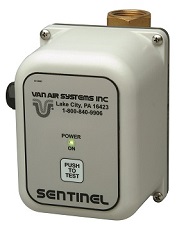Compressed Air Dryer System
Posted by Tyler on 05 17 2016
Achieving clean dry compressed air is not simply a question of picking the right air dryer. Choosing the right equipment is important, but you also have to think about how the dryer will work as an integrated part of a bigger system. A systems-based approach to dryer sizing and selection takes into consideration where the dryer will be located, how it will be operated, and how ancillary air treatment components affect the dryer’s performance and longevity.
Temperature plays a big role in affecting the performance of any compressed air dryer. This is principally because more water vapor is present in hot compressed air. A common rule of thumb is that for every 20⁰ F increase in compressed air temperature the amount water vapor in the air line doubles. So applying an air dryer at 120⁰ F versus 100⁰ F means introducing double the amount of water vapor to the dryer. This is why an effective after-cooler is arguably the most critical and overlooked component in any air treatment system. A good after-cooler will condense about 70% of water that exits the compressor as vapor.
Ambient temperature—as opposed to the process temperature, or the temperature of the air within the pipe--also has a big effect on certain air dryers, especially air-cooled refrigerated air dryers.Refrigerated air dryers are typically sized for operation in 100⁰ F ambient conditions.It’s quite common for a refrigerated dryer to be installed adjacent to the compressor itself.During the summer if the compressor room warms above 100⁰ F the performance of the dryer will decrease.
Consider intermittent high volume demands within the compressed air system. The purging of dust from bag filters is a classic example, where air nozzles use a tremendous volume of air for brief periods. Such bursts of demand if exceeding the capacity of the dryer may result in the introduction of wet and dirty air to the system. Is the answer to get a bigger dryer? No!! The answer is to have a dry air storage tank size sufficiently to buffer demand spikes. A dry air storage tank is installed after the dryer, serving essentially the same function that the wet air storage tank does for the compressor.
Condensate drains are an Achilles heel in many compressed air systems.The condensate drains represent a small fraction of the total air treatment system investment, but their importance is far greater than their cost. A failed automatic drain can easily negate the benefits of the dryer. This is why I always encourage my customers to invest wisely in an auto drain, such as the clog proof MDV-400I or fully pneumatic PDV-500T.
As always, contact me for application questions, advice, or quotes for air treatment equipment. tyler@moistureboss.com



